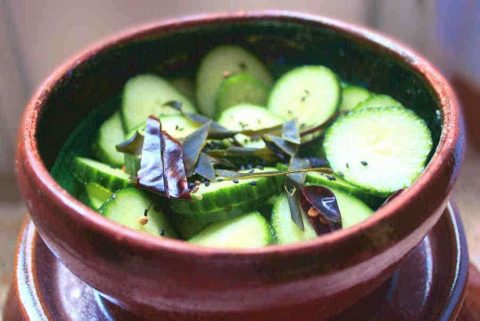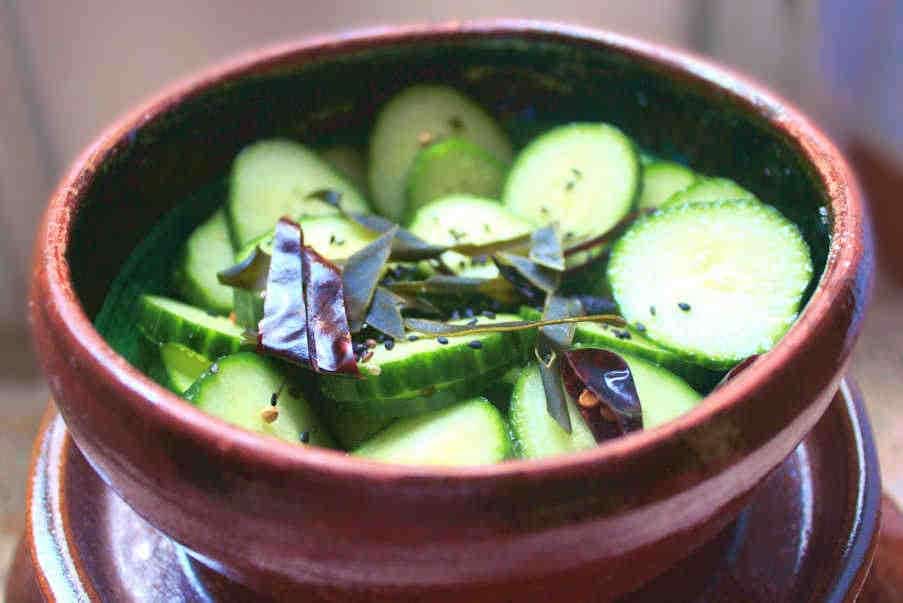Shiozuke
Salt Pickled Cucumber With Kelp And Chilli
Using salt to preserve food spans millennia. The earliest known records date back to 6000BC in an area around the Nile valley and Mesopotamia known as the fertile cresecent. Japan, however, has turned this process into the artform they call tsukemono
Tsukemono or “pickled thing” in Japan accompanies literally every meal, can be served over a bowl of rice and even forms part of the tea ceremony
The simplest tsukemono is salt pickled (shiozuke) and includes fermented and non-fermented varieties. Vegetables with a high water content such as cucumber are more usually lightly and briefly salted to extract water and concentrate their flavour without fermentation. Harder vegetables such as radishes, carrots and other root vegetables lend themselves well to fermentation
The lacto-fermented plums in the next post will serve as an example of the fermentation of fruit and veg
The principal of fermentation is to
- use salt (2-10% by total weight) to suppress the “bad” bacteria, while allowing the growth of salt-resistant “good” lactic acid bacteria
- ensure the fermentation takes place in the absence of oxygen, traditionally done by submerging the vegetables in brine
Basic Methodology
- salt can be added directly to the vegetables which are then rested to extract liquid which is used as a brine
- or the vegetables are steeped in a 5 – 10% salt : water solution or brine and
- in all cases the vegetable must be kept entirely submerged, usually with the help of weights to avoid air contact. Any part of the vegetable exposed to air will grow mould and other harmful micro-organisms and will spoil. You can buy special fermentation weights. I fill a sandwich bag with the same concentration brine, tie it with a strong knot and rest it on top of the veg. Foolproof
Pickling Times
- 5% brine requires 8 hours pickling and will last for 2-3 days
- 10% brine requires 5 hours of pickling and will keep closer to a week
Condiments
You can pickle vegetables with or witout extra condiments. This recipe uses kombu (sea kelp) and dried chilli with whole coriander seeds. Kelp is a natural source of umami, or deliciousness in the form of glutamate and related compunds, and is reputedly where MSG was first discovered before being synthesized for mass-production
The flavour combinations are basically limitless: for cucumbers try dill with sumak, or preserved lemon with black pepper. Experiment. Be bold!

- 1 cucumber thickly sliced
- 1/2 tsp non-iodized salt
- a few thin strips of kombu (dried sea kelp)
- a few thin strips of dried chilli
- 1 tsp whole coriander seeds
- put the sliced cucumber in a bowl with the salt and toss with your fingers to disperse the salt evenly. Add the coriander, kombu and chilli.
- rest, covered at least an hour and preferably 5 hours in the regrigerator. Set a timer so you don;t end up with overly salty vegetables
- VERY briefly rinse off the salt and use a clean tea towel or absorbent paper to absorb the excess water
- serve in a clean bowl with the kelp and chilli. Try garnishing with a few black sesame seeds
Subscribe To Posts

